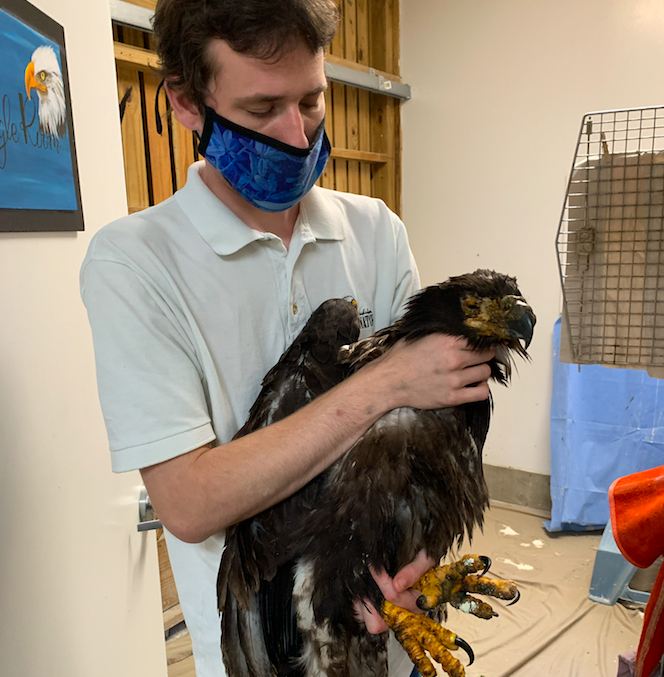Katie Warner, Center Director: David, if you could describe baby season at the Center to someone not familiar with our organization or programs, what would you say?
David Fitzpatrick, Seasonal Raptor Care Assistant: Total Chaos. Baby season really is chaotic as we have a certain capacity for the number of birds we can care for and a limited number of staff to care for them on any given day. So, to put this in perspective, if we have 35 birds in the Raptor Trauma clinic and really have the capacity to treat 30, that becomes challenging as each of these birds/babies need to be cared for four times daily.
KW: What does a typical day look like?
DF: Well during baby season, it is hard to call any day typical. We start out the morning with food and patient prep. Each bird's food dish and meds are set out and labeled; patients are fed in order of priority of importance: tiny nestlings that need to be fed five times daily, then to the four times daily and so on. Though we may be caring for 20 babies, you’re treating and caring for each bird multiple times daily.
KW: What do you feed the babies? I see you have jarred baby food on the Center’s wish list, what do we use that for?
DF: Food really depends on the age of the bird. We feed chicks or mice mainly. Tiny young nestlings one to two days old can’t handle fur or bone so we supplement with chicken or turkey varieties of baby food. We also use baby food for emaciated patients. If a raptor is severely underweight, that means it is starving to death. Solid meals take energy, so to boost energy we give fluids and baby food as a kick start to get the body re-introduced to nutrients and food. As they progress, their diet includes more solid foods.

KW: How do you know when a baby is well enough to be released?
DF: As a baby progresses, they are moved from the Raptor Trauma Clinic to our outside mews areas. Right now we have a nursery set up for Red-shouldered Hawks. If a bird is outside we have to make sure they are not super friendly towards people - this is important! A raptor that associates with people won’t have social skills or hunting skills to be able to survive on its own.
Young birds need to be able to hunt on their own. Sometimes we use live prey to be able to teach them to hunt. Additionally, babies must be able to fly well. Flight conditioning for raptors has to be near-perfect. For example, Peregrines Falcons have to have perfect flight to survive in the wild.
KW: I know you have been a volunteer for six years and this year you are a staff member. What was the biggest challenge during the pandemic—specifically during baby season?
DF: The biggest challenge is trying to make sure that everybody stays healthy in the clinic and down at the rehabilitation areas. If just one staff member got sick, staff would be more strained than ever, with the possibility of having to close a program area. We worked hard to follow protocols and keep staff safe. We implemented safety measures and limits of the number of people in clinic for patient care, but as baby season kept going, we had to increase it to treat birds and spread out into other areas. We also had to trust people that when they went home they were being careful at home and being safe.
KW: What’s the best thing about baby season? Is there a silver lining?
DF: Even though this time is chaotic, most of the babies we admit don’t have long lasting injuries so we are able to release them. Approximately 80 or more of babies receive are eventually released or returned to their nest/families. Giving them that best chance for release back into the wild is the best part. I also enjoy working with this team – six years as volunteer and now as a staff member. The Center for Birds of Prey has a strong team - we have managed to get through 40+ baby seasons, so this is not our first, and not our last!
To learn more about the Raptor Clinic, click here. To support the Center for Birds of Prey during baby season, click here for their Amazon wishlist.





